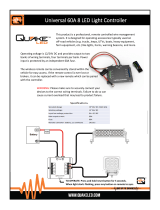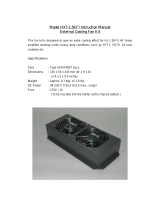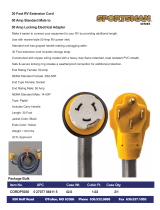
18 | SAMLEX AMERICA INC.
1. Switched mode power supplies (SMPS) employ high frequency switching and thus, are
a source of radio interference, a recipient of radio interference and a conduit of radio
interference (older linear type transformer based power supplies do not employ high
frequency switching voltages and will be quieter as compared to switching type of
supplies ).
2. The primary emission sources originate in the switching devices due to their fast
switching current transitions: harmonics of the switching frequency and broadband
noise created by under-damped oscillations in the switching circuit. The secondary
source is from the bridge rectier, both rectier noise and diode recovery. The AC
input rectier / capacitor in the front end of the switching power supplies (except-
ing those with power factor correction) are notorious for generating power supply
harmonics due to the non linear input current waveform. The noise is both conducted
and radiated through the Input power cord and the DC output wiring to the radio.
Filters are used to limit the noise to acceptable level.
3. Switching power supplies are also recipients of radio interference. The normal op-
eration of the power supply can be disturbed due to RF noise getting coupled into
the power supply. Thus, the power supply may generate excessive RF noise and lose
output voltage regulation due to excessive transmitter energy being coupled through
the AC/DC lines to the power supply’s regulator feedback path. This may be due to
antenna being too close or due to the antenna or feed system not radiating properly.
First check the antenna system SWR. Then, if necessary, relocate either the antenna or
the power supply farther apart.
4. The receiver may “hear” the power supply. A slowly moving, slightly buzzing carrier
heard in the receiver may be caused by the antenna being too close. As with the
transmitter related noise pick up, a loose coaxial connector or a broken or a miss-
ing ground may aggravate this problem. Normally these noises will be below the
background or “band” noise. Increase the separation between the power supply and
the receiving antenna. Use an outdoor antenna. This will reduce the amount of signal
picked up from the power supply and also increase the amount of the desired signal.
5. The conducted RF noise from these power supplies is limited to the maximum allow-
able levels by internal ltration. The ltered RF noise currents are by-passed to the
chassis of the power supply. The chassis is, in turn connected to the earth ground pin
of the AC input power cord (for Class 1 units). Thus, the ltered noise currents are
intentionally leaked to the earth ground. This is termed as the “earth leakage cur-
rent”. For safety against electric shock, this earth leakage current is also required to
be limited. It will be seen that these two requirements are conicting.
NOTE:
- In some cases, to prevent electric shock hazard due to abnormal leakage current
(like in marinas, spas, hot tubs, wet spaces etc.), The AC outlet circuits / receptacles
in these areas are served through a GFCI ( ground fault circuit interrupter ). This
GFCI is normally set to trip when it senses an earth leakage current > 5 mA. A single
GFCI may be serving multiple AC outlet circuits / receptacles and therefore, will be
sensing the sum of all the leakage currents of the devices connected to these. As
the switching power supplies have intentional leakage current.
SECTION 13 | Limiting Electromagnetic
Interference (EMI)
























